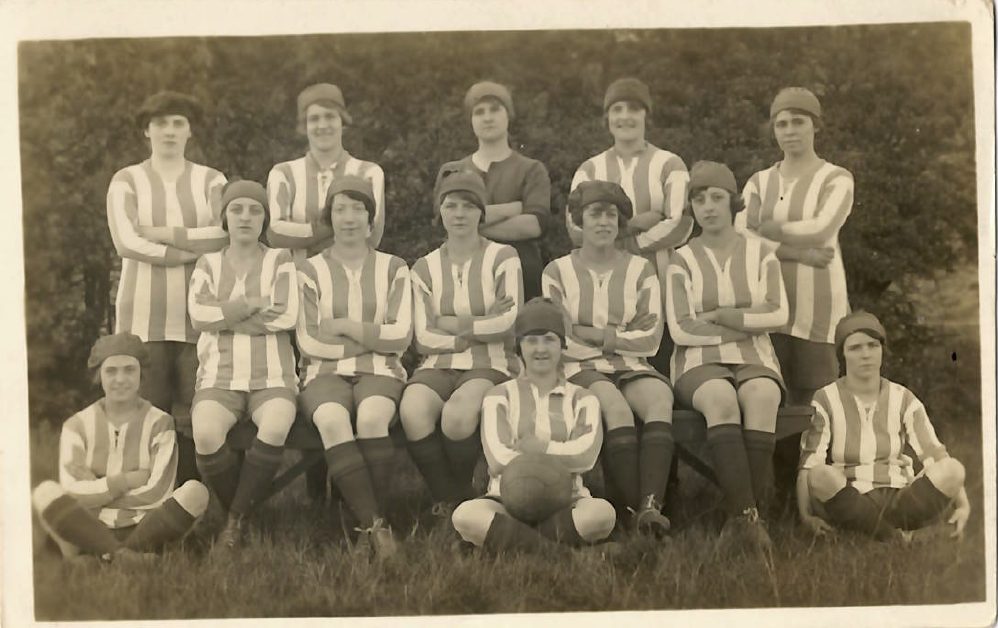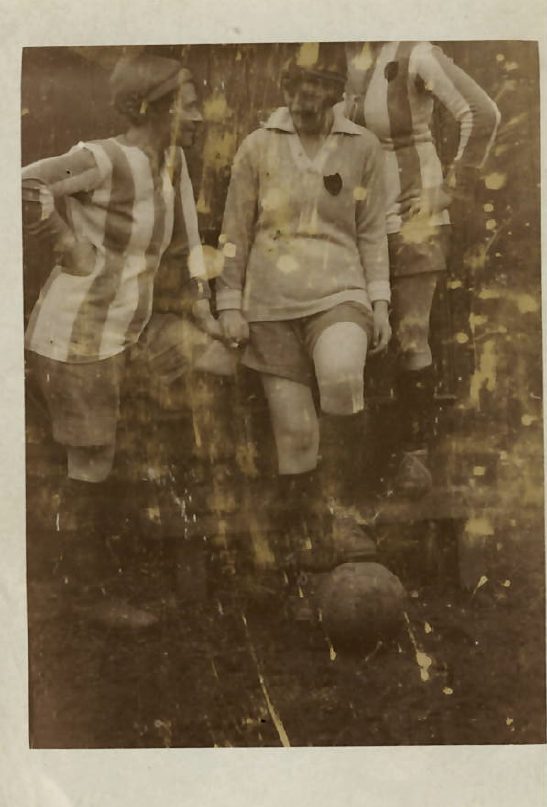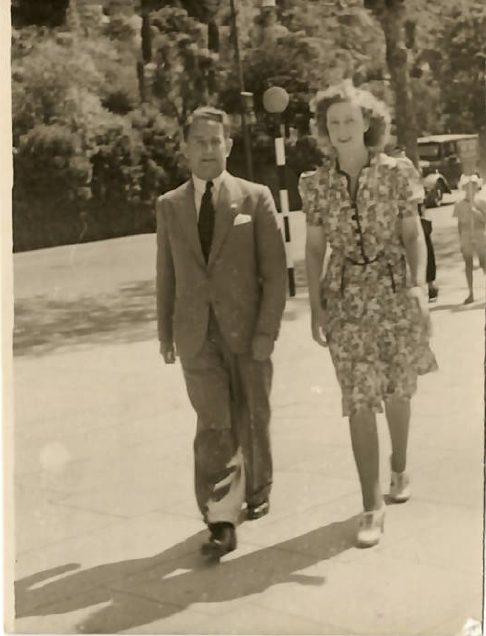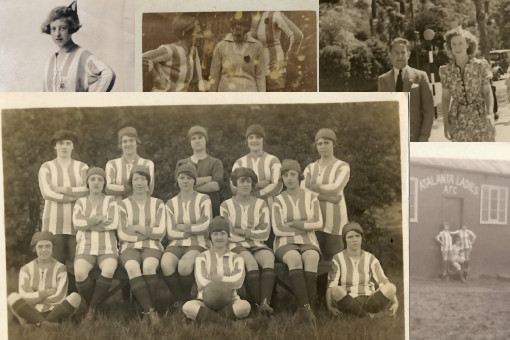Huddersfield Town Supporters’ Association has inducted women’s football pioneer Constance Waller into the Huddersfield Town Heritage Project Hall of Fame.
The honour came about after HTSA was contacted by Penny Mannings who asked whether they might be interested in several items that had recently come into her possession.
It turned out that Penny’s maternal grandfather’s second wife was Constance Waller, who was one of the founders of Huddersfield Atalanta Ladies, a pioneering women’s football team set up in Crosland Moor in November 1920. She later became one of the first female football writers when she reported for the Huddersfield Daily Examiner in the 1950s.
As a result of this connection five never-seen-before photographs of Constance are now in the public domain.
Lost, Found, Shared
While sorting through her late mother’s belongings, Penny Mannings found a large pack of newspaper clippings from the period 1932 to 1938. Each clipping had been written by Constance Waller. Although she had never met Constance, Penny knew that she was her maternal grandfather Harold Barkworth’s second wife, and, therefore, technically her step-grandmother.
Intrigued, Penny did some further digging, discovering a series of photographs depicting Constance and other women in various football settings. A big clue as to their provenance came in the form of the words ‘Huddersfield Atalanta Club – Football Team – 1921’ inscribed on the bottom of one of the team portraits.
Penny’s boss, who has a keen interest in all things sporting, informed her that, in a case of pure serendipity, the Marsden-based Mikron Theatre was touring an Amanda Whittington play entitled Atalanta Forever—and, even more remarkably, Constance was the one of the main characters.
Chair, Captain, Goalscorer
Constance, who later went by the name Mary, was the founder of the Atalanta Sports Club, which from November 1920 aimed “to provide games for the women of Huddersfield, to foster a sporting spirit, and love of honour among its members.”
It was Birkby-born Constance who chose the club’s unique moniker – an ode to the heroine from Greek mythology who could beat any mortal, male or female, in a foot race. She was not, however, content to play the role of muse. On the contrary, she chaired and captained the football side from its base at Sands House in Crosland Moor, even chipping in with a few goals now and then.
Much is known about Atalanta and Constance’s exploits in 1921: how they captured the public’s imagination, drawing more than 15,000 fans to Leeds Road for their tie with Bath Ladies; how they played the legendary Dick, Kerr Ladies at Hillsborough in front of a crowd of 25,000; how they went to-to-toe with a French XI team at Fartown; how they trained with Huddersfield Town icons such as Billy Smith; how they raised thousands of pounds for local charities and good causes; and how they limped on after the Football Association banned the women’s game on December 5 of the same year.
And then, silence.
Feminist, Journalist, Pioneer
Well, not quite.
Described by one of her contemporaries as an “advanced feminist”, the bob-haired Constance appeared to care little for the rules, opinions, and obstacles of the patriarchy.
Ever the torchbearer, in the years following the ban, she went on to become the Huddersfield Daily Examiner’s first female journalist.
She must have made quite the impression because, as an article in the very same newspaper beamed in January 1958, she was “probably also the first woman to sit shoulder to shoulder with male colleagues in the press box reporting football matches for the national press.”
And it was not just football. In the 1930s, Constance’s pieces for the Daily Express and Sunday Express covered a wide range of topics, including the career of the so-called “Hercules of Huddersfield”, wrestler Douglas Clark.
Loss, Recovery, Legacies
Reflecting on her connection with Constance, Penny said: “I never met her, which may have been her choice, and had no idea of her existence.
“My grandparents were divorced in the Old Bailey, and it was a big thing. I imagine the stigma meant that there was no mention of what happened next.
“Looking at the text of the articles, and how innovative she was in women’s football, I think she is someone who I would have liked to meet. She clearly had a sense of humour and a sharp mind. I am also a sports fan and I believe we would have been good friends.”
As much as Constance was lost to Penny, she was lost to the rest of us. Like many women footballers from the inter-war period, Constance appears to have kept quiet about her footballing past. Now the contribution made by Constance, her Atalanta sisters and others of that generation is being remembered.
Girls and women are an integral part of the story of football in Huddersfield and beyond. They have always played a starring role.
For that reason, and to make good on the clarion call, “Atalanta Forever”, HTSA have decided to induct Constance Waller into the Huddersfield Town Heritage Project Hall of Fame.
Photographs
As far as HTSA can tell, Penny’s haul includes five photographs that the public have never laid eyes on.
Photograph number one shows a proud Constance in a Huddersfield Town shirt. This is strikingly similar to a portrait of an unknown Atalanta player that appeared on eBay some years ago:

Number two is a team photograph, presumably taken in the summer of 1921 or 1922. We think Constance is on the far right of the middle row:

Number three shows three Atalanta players outside the club house in Crosland Moor (we think), while the nurse from the famous 1921 team photo glares through a window:

Number four is a snapshot of three Atalanta players (again, we think) leaning against a wall:

And, finally, number five shows Constance and Harold walking in the sunshine, maybe sometime in the 1950s:

Find out more about the history of women’s football in Huddersfield by browsing the Heritage Project’s two dedicated primary source collections: Women’s Football Archive and Women’s Football Timeline.
















